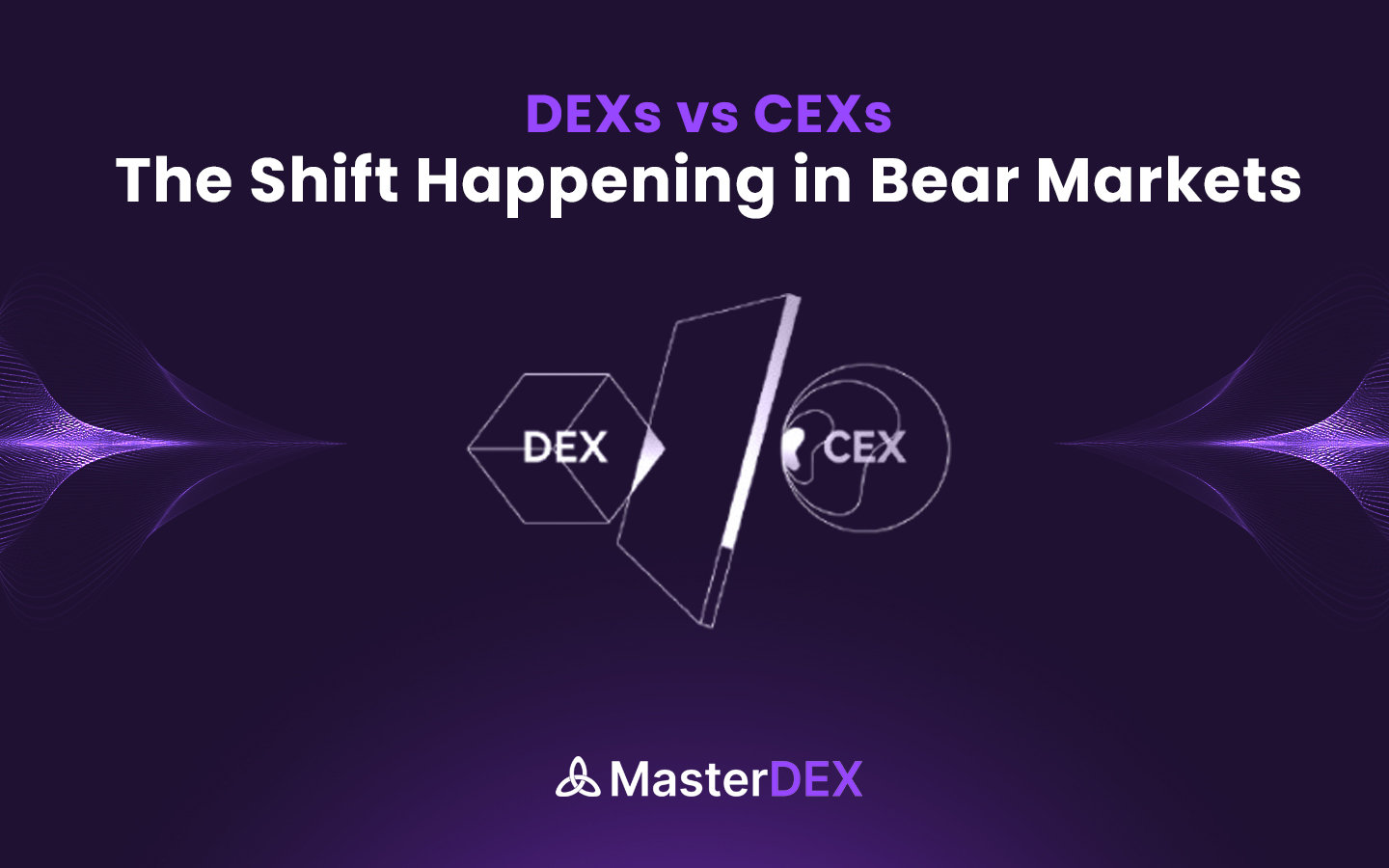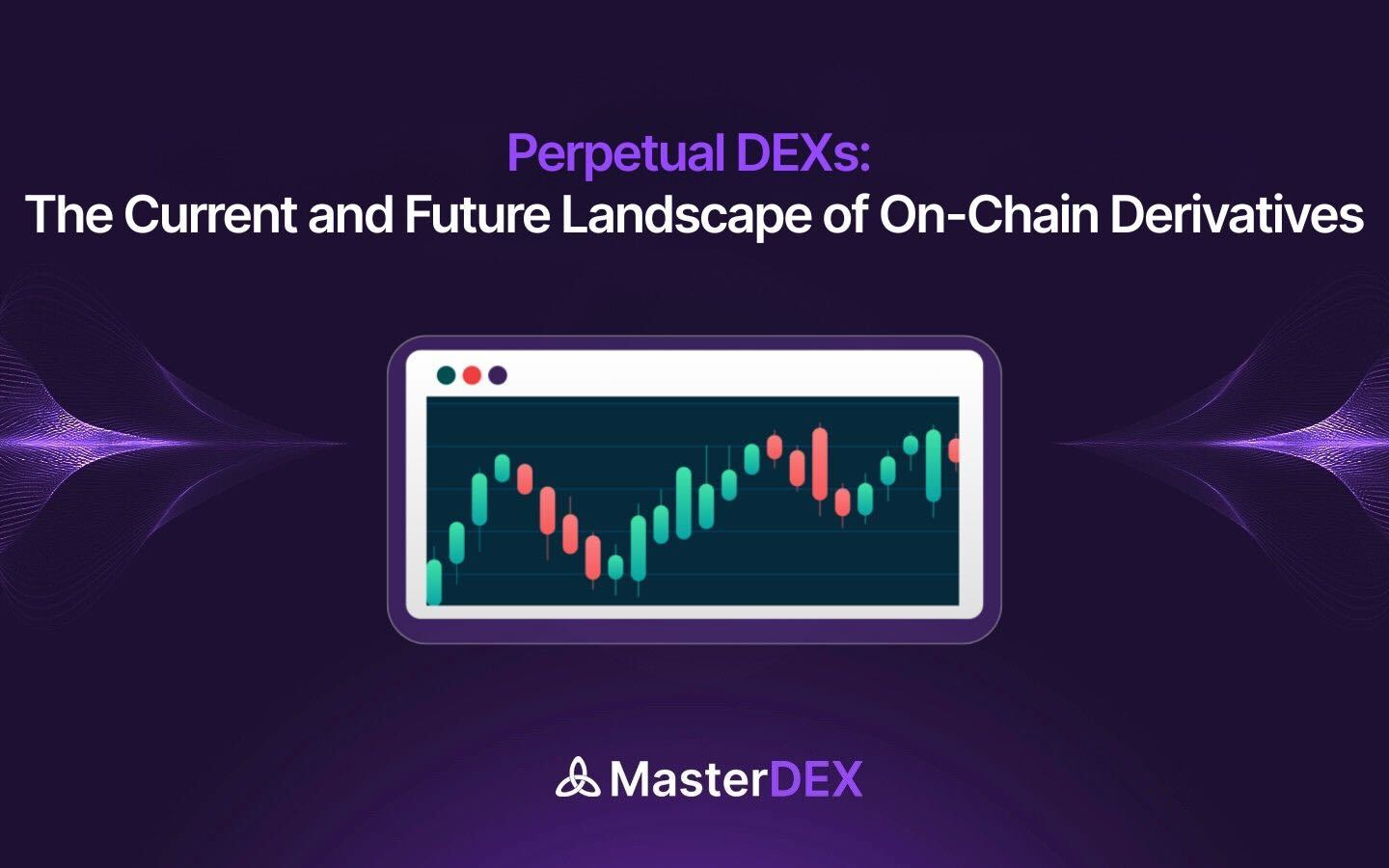Table of Contents:
ToggleIntroduction
The crypto market is no stranger to volatility. While bull markets bring in new users, frenzied trading, and skyrocketing valuations, bear markets reveal the true resilience of platforms and protocols. They strip away the hype and expose the foundations upon which crypto services are built. And in recent downturns, a surprising shift has taken shape. Decentralized exchanges (DEXs) are not just surviving the storm; they’re quietly outpacing their centralized counterparts (CEXs).
Gone are the days when DEXs were viewed merely as experimental alternatives, plagued by clunky interfaces, high slippage, and minimal liquidity. Today, they’ve matured into robust ecosystems with high-volume trading pairs, powerful incentives, and interfaces that rival CEXs. Offering security, transparency, and true asset ownership, DEXs deliver benefits that centralized platforms often struggle to match—especially in an environment where trust is scarce and users are more cautious.
As scandals, insolvencies, and regulatory clampdowns hit major CEXs, the narrative is changing. More users are seeking platforms that return control to their hands. What’s emerging is not just a technical or financial evolution, but a paradigm shift in how people engage with digital assets—and DEXs are right at the center of this movement.
This article dives deep into the reasons behind this transition. We’ll explore the structural strengths of DEXs, the psychological shift in user behavior, the innovation that fuels DEX dominance, and the hard data that proves they are no longer a niche corner of DeFi. DEXs are rising, not just in relevance, but in resilience—and they’re doing it when it matters most.
Why DEXs Thrive When Markets Fall
When the markets turn red and centralized institutions begin to crack under pressure, decentralized exchanges stand tall. Their architecture—rooted in transparency, autonomy, and user control—offers a kind of structural integrity that’s tailor-made for turbulent times. Before we explore how DEXs are outpacing CEXs in bear markets, it’s essential to understand the foundational advantages that give them this resilience.
1. The Resilience of DEXs: Understanding the Structural Advantage
Trustlessness and Transparency
In times of market uncertainty, trust becomes a premium commodity. Centralized exchanges have long been the go-to platforms due to their polished user experience and deep liquidity. However, many users have learned—sometimes the hard way—that trusting a central authority with your funds introduces serious risk. Scandals like Mt. Gox, QuadrigaCX, and more recently, the collapse of FTX, shook user confidence to its core. These events serve as painful reminders that CEXs, despite their scale, can be fallible.
DEXs present a fundamentally different approach. Operating on open-source smart contracts and enabling fully on-chain trading, they allow anyone to verify operations in real time. This transparency builds user confidence because they can audit the system themselves. The smart contracts are immutable once deployed, and any vulnerabilities or flaws are visible to the public. It’s a trustless system—because trust isn’t required. That’s a powerful promise in bearish markets, where even established institutions are under fire.
Moreover, because users retain custody of their assets on DEXs, they are less vulnerable to freezes or mismanagement. In contrast, CEX users must trust that their funds won’t be misappropriated or locked due to regulatory action or internal failure. In times of uncertainty, this one feature alone makes DEXs a haven for those seeking security and autonomy.
To know more about DEX vs CEX, check out this blog post.
Liquidity Resilience Through Incentives
Liquidity is the lifeblood of any exchange. Without it, trades cannot be executed efficiently. CEXs typically rely on order books and market makers to provide this liquidity. In bear markets, however, these institutional players often scale back participation or pull out entirely, drying up markets and increasing slippage for retail users.
DEXs operate differently. They leverage liquidity pools—automated smart contracts into which users deposit assets to enable trading. These pools are often bolstered by attractive incentives: farming rewards, governance tokens, or even protocol-owned liquidity mechanisms that stabilize TVL (Total Value Locked). Yield remains a powerful motivator. Even when prices are down, users remain engaged through the promise of compounding returns.
Protocols like Curve, SushiSwap, and Balancer continually adapt their reward structures to balance incentives and maintain healthy liquidity pools. This agile mechanism ensures that even in harsh market conditions, DEXs can maintain tradeable liquidity levels. And because the liquidity is often provided by the community itself, it becomes stickier and more resilient than the institutional liquidity on which many CEXs depend.
2. User Behavior Shift: The DeFi Mindset in Bear Markets
From Speculation to Ownership
Bull markets often breed speculation—quick flips, meme coin gambling, and copy trading dominate user behavior. Bear markets, by contrast, promote introspection and long-term thinking. Users begin to question the platforms they use and the principles they support. This is where DEXs excel: by offering more than just a place to trade, they provide a chance to participate.
DEXs empower users to become part of the ecosystem: as liquidity providers, governance participants, and contributors to protocol development. Governance tokens like UNI, CRV, or BAL are more than just speculative assets—they represent votes, influence, and a share in the direction of the protocol. Yield from transaction fees or protocol-owned incentives can create ongoing passive income, giving users a stake in the success of the platform.
This culture of ownership has a profound impact during bear markets. Instead of abandoning platforms due to price drops, engaged users stay loyal, propose changes, and continue interacting with the protocol. It’s no longer just about trading; it’s about building and sustaining a decentralized financial ecosystem.
Privacy, Sovereignty, and Geographic Flexibility
Another significant reason users are flocking to DEXs is the increasing surveillance and compliance pressure on centralized exchanges. Governments worldwide are tightening regulations, requiring CEXs to implement strict KYC and AML procedures. While this may improve oversight, it also alienates users who value privacy or come from regions where financial inclusion is limited.
DEXs offer an alternative. By design, they are permissionless—anyone with a crypto wallet can trade, provide liquidity, or stake tokens without needing to submit personal documents. This opens financial access to users in jurisdictions with poor infrastructure, capital controls, or hostile regulation. During times of economic or political instability, DEXs become more than a convenience; they become a critical financial lifeline.
In a bear market, when trust in institutions is already shaken, the privacy and autonomy afforded by DEXs make them a more attractive, and sometimes necessary, option for a growing demographic of crypto users.
3. Innovation and Incentives: What Keeps DEXs Competitive
Trading Rewards and Airdrops
DEXs have mastered the art of incentivization. Many platforms reward users simply for trading, providing liquidity, or staking tokens. This turns passive users into active participants, helping drive platform activity even when speculative interest declines. These incentives are particularly powerful in a bear market, when users are looking for ways to offset portfolio losses.
One standout example is GMX, a decentralized perpetual exchange that shares protocol fees directly with stakers in the form of ETH or AVAX. This model offers true revenue sharing—something most CEXs don’t provide. Uniswap, while more passive in its fee model, has rewarded early users with generous airdrops in the past, creating a precedent and expectation for retroactive rewards across the DEX landscape.
These strategies generate engagement even when trading volume slows. Users feel valued and incentivized, not just as traders, but as stakeholders in a growing system.
Composability and Layer 2 Scaling
One of DeFi’s greatest strengths is its composability—applications can stack on top of one another like financial Lego bricks. A DEX is not just a place to swap tokens; it can be integrated with lending platforms, yield optimizers, insurance protocols, and more. This creates a synergistic ecosystem where users can maximize returns and customize strategies.
This interconnectivity is lacking on most CEXs, where products are siloed and offer little interoperability. In contrast, a user can seamlessly route tokens through Uniswap, deposit them into Aave, hedge with options on Lyra, and earn rewards on Yearn—all without leaving the DeFi ecosystem.
Layer 2 solutions like Arbitrum, zkSync, Optimism, and Base have also significantly reduced gas fees and transaction times, making DeFi more accessible. These upgrades have transformed DEXs into fast, cost-effective platforms that no longer lag behind CEXs in terms of usability.
4. The Numbers and Narratives: Data Doesn’t Lie
Volume Recovery and TVL Stability
Despite a challenging macroeconomic environment, DEXs have demonstrated notable resilience in both trading volumes and TVL. According to recent data, decentralized exchanges recorded $668.7 billion in monthly trading volume as of May 2025, surpassing 52% of all crypto trades.These are not just temporary spikes. They reflect a growing trust in decentralized platforms, fueled by a shift in user behavior and institutional interest. Platforms like Uniswap and Curve have maintained dominance, and up-and-coming projects are innovating at a pace unmatched by CEXs.
Total Value Locked has remained stable and, in some cases, growing, driven by new narratives like Real World Assets (RWAs), liquid staking derivatives (LSDfi), and tokenized bonds. These evolving DeFi primitives continue to attract capital, even as risk appetite declines elsewhere in crypto.
Institutional DeFi is Emerging
Institutions are no longer ignoring DeFi. BlackRock has dipped its toes in tokenized funds, Chainlink’s Cross-Chain Interoperability Protocol (CCIP) is creating secure cross-chain data flows, and MakerDAO is onboarding tokenized treasury bills as collateral. These are not isolated experiments; they are early indicators of institutional DeFi becoming a major vertical.
DEXs are increasingly integrating compliance features like KYC pools, risk management dashboards, and audit trails, allowing institutions to engage while adhering to regulations. While CEXs may remain the gateway for fiat conversions and onboarding, the lion’s share of innovation and soon, liquidity is shifting toward decentralized rails.
Concluding Lines: Why DEXs Matter More Than Ever
While centralized exchanges still play a crucial role in the crypto ecosystem, especially for fiat onboarding, the decentralized exchange landscape is proving itself not just viable, but formidable. In an environment where trust is fragile, fees matter more, and ownership is everything, DEXs offer solutions that speak to the values of the modern crypto user.
As infrastructure improves, interfaces become sleeker, and cross-chain integrations become the norm, DEXs will continue their march toward mainstream adoption. The next bull run may well be fueled not by centralized platforms, but by the robust, transparent, and resilient infrastructure being built in DeFi today.
If the last cycle was defined by speculation, the next may be defined by sovereignty and in that race, DEXs are already pulling ahead.



